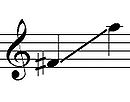Duduk
|
Duduk - also known as ծիրանափող (tsiranapogh) in Armenian
|
|
| Classification | Wind instrument with double reed |
|---|---|
| Playing range | |
| Musicians | |
| Djivan Gasparyan, Gevorg Dabaghyan, Pedro Eustache, Vache Sharafyan, Didier Malherbe | |
The duduk (doo-dook) is an ancient double-reed woodwind flute made of apricot wood. It is indigenous to Armenia. It is commonly played in pairs: while the first player plays the song, the second plays a steady drone, and the sound of the two instruments together creates a richer, more haunting sound.
The unflattened reed and cylindrical body produce a sound closer to the English horn than to more commonly known double-reeds. Unlike other double reed instruments like the oboe or shawm, the duduk has a very large reed proportional to its size. UNESCO proclaimed the Armenian duduk and its music as a Masterpiece of the Intangible Heritage of Humanity in 2005 and inscribed it in 2008. Duduk music has been used in a number of films, most notably in The Russia House and Gladiator.
Variations of the duduk exist in Eastern Europe, the Middle East and Central Asia, including the balaban in Azerbaijan and Iran.
The word "duduk" (Armenian: դուդուկ) is derived from Turkish "düdük" which means whistle. The word dudka in Slavic languages is a diminutive of duda and is of native Proto-Slavic origin.
This instrument is not to be confused with the northwestern Bulgarian folk instrument of the same name (see below, Balkan duduk).
The duduk is a double reed instrument with ancient origins, having existed since at least the fifth century, while there are Armenian scholars who believe it existed more than 1,500 years before that. The earliest instruments similar to the duduk's present form are made of bone or entirely of cane. Today, the duduk is exclusively made of wood with a large double reed, with the body made from aged apricot wood.
...
Wikipedia

